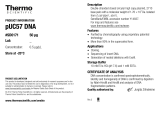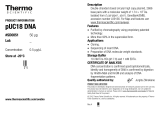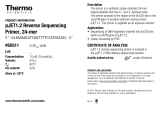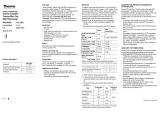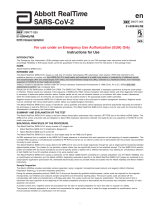Page is loading ...

PRODUCT INFORMATION
Thermo Scientific
DyNAzyme II DNA
Polymerase
#F-501L 1000 U
Lot __ Expiry Date __
Store at -20°C
www.thermoscientific.com/onebio
Ordering information
Component
#
F
-
501S
250 U
#
F
-
501L
1000 U
DyNAzyme II DNA
Polymerase, 2 U/µL 125 µL 500 µL
10X Optimized DyNAzyme
Buffer 2 × 1.5 mL 4 × 1.5 mL
Rev.3
V
Description
Thermo Scientific™ DyNAzyme™ II DNA Polymerase is
a thermostable DNA polymerase for routine DNA
amplification. It possesses 5’→3’ DNA polymerase
activity and 5’→3’ exonuclease activity, but lacks the
3’→5’ proofreading activity. DyNAzyme II DNA
Polymerase is free of contaminating endo- and
exonucleases. It has a half life of 2.5 h at 96 °C.
Source
E.coli strain expressing the cloned DyNAzyme DNA
Polymerase gene from Thermus brockianus, Thermo
Scientific’s proprietary bacterial strain.
Definition of Activity Unit
One unit is defined as the amount of enzyme that will
incorporate 10 nmoles of dNTPs into acid-insoluble form
at 74 °C in 30 minutes under the stated assay conditions:
20 µg activated calf thymus DNA and 0.5 µCi [α-
32
P]
dCTP are incubated with 0.1 units DNA polymerase in
50 µL incubation buffer at 74 °C for 10 minutes. The
amount of incorporated dNTPs is determined by
trichloroacetic acid precipitation.
Enzyme activity is assayed in the following mixture:
25 mM TAPS-HCl, pH 9.3 (at 25 °C), 50 mM KCl,
2 mM MgCl
2
, 1 mM β-mercaptoethanol, 100 µM dCTP,
200 µM each dATP, dGTP, dTTP.
Storage Buffer
20 mM Tris-HCl (pH 7.4 at 25 °C), 0.1 mM EDTA,
1 mM DTT, 100 mM KCl, stabilizers, 200 µg/mL BSA and
50% glycerol.
10X Optimized DyNAzyme Buffer (F-511)
In final 1X reaction concentration the Optimized
DyNAzyme buffer contains 10 mM Tris-HCl
(pH 8.8 at 25 °C), 50 mM KCl, 1.5 mM MgCl
2
and
0.1 % Triton
®
X-100.
Guidelines for using DyNAzyme II DNA
Polymerase
Mix and centrifuge all tubes before opening to ensure
homogeneity and improve recovery. Always pipette
DyNAzyme II DNA Polymerase carefully and gently. The
high glycerol content (50%) in the storage buffer may
otherwise lead to pipetting errors.
Table 1. Pipetting instructions (add items in this order)
Component
Volume
Final conc.
H
2
O
add to 50
µL
10X Optimized DyNAzyme
buffer 5 µL
1X
(1.5 mM MgCl
2
)
10 mM dNTPs
1
µL
200 µM each
Primer A
X
µL
0.5 µM*
Primer B
X
µL
0
.5 µM*
Template DNA
X
µL
DyNAzyme II DNA
Polymerase 0.25–1 µL**
0.01
-
0.04
U
/µM
(0.5–2 U/50 µL)
* The recommendation for final primer concentration is 0.5 µM but it can
be optimized between 0.2–1.0 µM, if needed.
** Possible enzyme dilutions are recommended to be made in 1X reaction
buffer or H2O immediately before use.
Table 2.Cycling instructions.
Cycle step
2-step protocol 3-step protocol
Cycles
Temp.
Time Temp. Time
Initial
denaturation 94 °C
1-2 min 94 °C 1-2 min 1
Denaturation
Annealing
Extension
94
°C
-
72 °C
1
5 s
-
1 min
-
40 s/kb
94
°C
Tm-5 °C
72 °C
15 s
–
1 min
10-30 s
40 s/kb
25-35
Final Extension
72
°C
4 °C
5
-
10
min
hold
72
°C
4 °C
5
-
10 min
hold 1
Notes about reaction components
Enzyme
The optimal amount of enzyme depends on the amount
of template and the length of the PCR product. Usually
1 unit of DyNAzyme II DNA Polymerase per 50 µL
reaction volume gives good results, but the optimal
amount can range from 0.5 to 2.0 units per 50 µL reaction
depending on the length and difficulty of the amplicon.
Optimized DyNAzyme Buffer
For standard PCR reactions, optimized DyNAzyme buffer
is recommended (1X buffer contains 1.5 mM Mg
2+
). In
case Mg
2+
optimization is required, we recommend
DyNAzyme II DNA Polymerase with Mg
2+
-free
DyNAzyme buffer and MgCl
2
solution (#F-503).
dNTPs
High quality dNTPs should be used for optimal
performance with DyNAzyme II DNA Polymerase. The
polymerase also incorporates dUTP, dITP and
fluorescently-labeled nucleotides.
Template
General guidelines for low complexity DNA (e.g. plasmid,
lambda or BAC DNA) are: 1 pg–10 ng per 50 µL reaction
volume. For high complexity genomic DNA, the amount
of DNA template should be 50–500 ng per 50 µL reaction
volume. If cDNA synthesis reaction mixture is used
directly as a source for the template, the volume used
should not exceed 10% of the final PCR reaction volume.
PCR additives
PCR additives such as DMSO, formamide, glycerol and
betaine are compatible with DyNAzyme II DNA
Polymerase. We recommend using PCR additives in the
following concentrations: DMSO 2–10%, formamide
2–10%, glycerol 5–10%, or combinations of these.
Recommended starting point is 5% DMSO.
Note: If high DMSO concentration is used, the annealing
temperature must be decreased, as DMSO alters the
melting point of the primers. It has been reported that
10% DMSO decreases the annealing temperature by
5.5–6.0°C.
1
Notes about cycling conditions
Denaturation
After an initial 1–2 min denaturation at 94 °C, keep the
denaturation time as short as possible (usually
30 seconds or less at 94 °C).
Note: The denaturation time and temperature also
depend on the ramp rate and temperature control mode
of the cycler.
Primer annealing
The Tm’s should be calculated with the nearest neighbor
method
2
as results from primer Tm calculations can vary
significantly depending on the method used. Instructions
for Tm calculation and a link to a calculator using a
modified nearest-neighbor method can be found on
www.thermoscientific.com/tmc. We suggest the primers
to be annealed for 30 seconds or less at the highest
temperature that will permit annealing of the primers to
the template. A guideline for DyNAzyme II DNA
Polymerase is to use annealing temperature 5 °C below
the lower Tm of the primers. Two-step cycling without an
annealing step is recommended for high Tm primer pairs.
Extension
The extension for standard PCR should be performed
at 72 °C (40 seconds per one kilobase of amplified
product).
(continued on reverse page)

CERTIFICATE OF ANALYSIS
DNA amplification assay
Performance in PCR is tested by the amplification of
500 bp lambda DNA and 6 kb M13 DNA.
Exonuclease contamination assay
Incubation of 10 U for 4 hours at 72 °C in 50 µL assay
buffer with 1 µg sonicated [
3
H] ssDNA (2 × 10
5
cpm/µg)
released < 1% of radioactivity.
Endonuclease contamination assay
No endonuclease activity is observed after incubation of
10 U of DNA polymerase with 1 µg of lambda DNA or
lambda HindIII DNA fragments in assay buffer at 72 °C
for 4 hours.
Quality authorized by: Jurgita Zilinskiene
References
1. Chester N. & Marshak D.R. (1993) Analytical
Biochemistry 209: 284–290.
2. Breslauer K.J. et al., (1986) PNAS 83: 3746–3750.
PRODUCT USE LIMITATION
This product is developed, designed and sold exclusively for research
purposes and in vitro use only. The product was not tested for use in
diagnostics or for drug development, nor is it suitable for administration to
humans or animals. Please refer to www.thermoscientific.com/onebio for
Material Safety Data Sheet of the product.
© 2014 Thermo Fisher Scientific, Inc. All rights reserved. All trademarks
are the property of Thermo Fisher Scientific Inc. and its subsidiaries.
/

